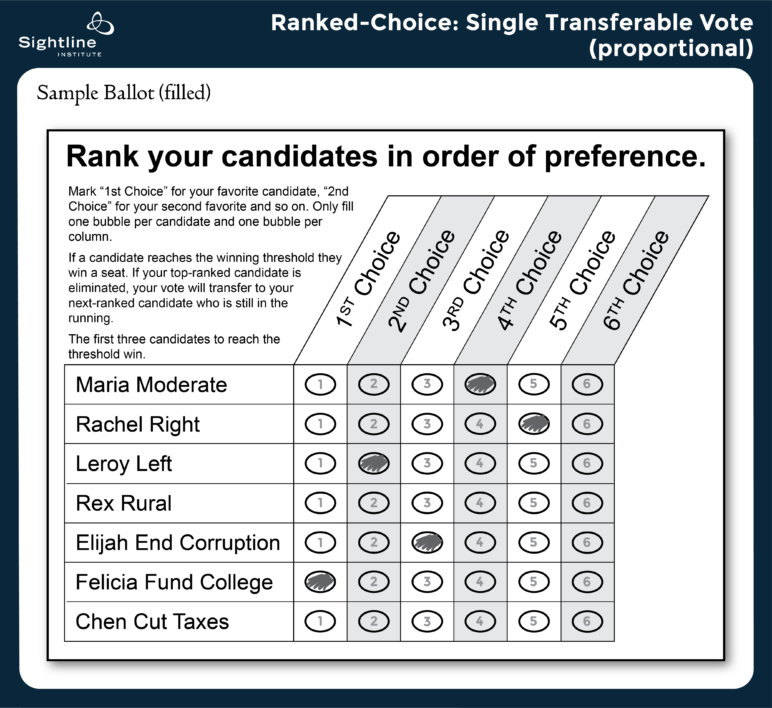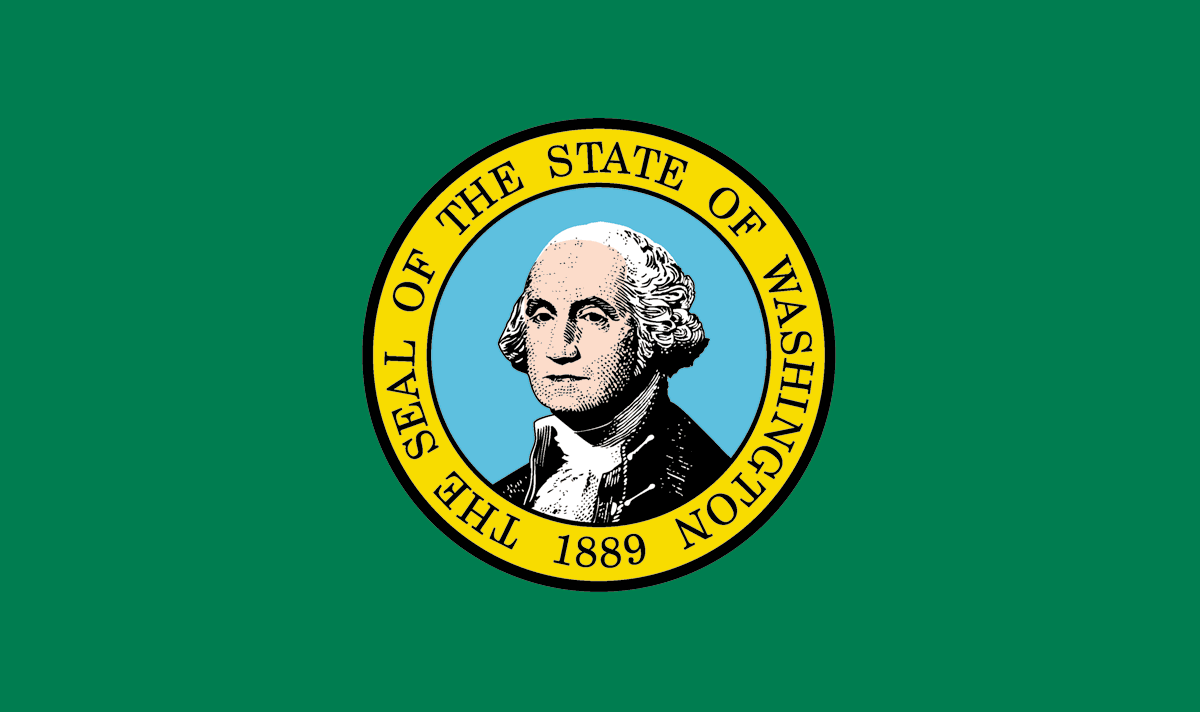As the introductory article in this series describes, Washingtonians have many reasons to adopt proportional representation for their state legislature: to give voters more voice, to ease partisan gridlock, to reduce the power of gerrymandering, to limit the outsize influence of special interests, and to make campaigns less expensive.
But how can they do it?
This article describes the first of four options. Each relies on reconfiguring the state’s legislative districts to allow for multi-winner races and adopting a voting method that achieves proportional results, such as multi-winner ranked-choice voting. This structural change would make the districts less vulnerable to gerrymandering and would allow voters to win fairer representation.
This first option would not require drawing any new district lines, and it would maintain the current number of legislators in each house. Consequently, voters could approve this option and the state could implement it before the next redistricting commission meets in 2021.
Merge existing districts together to create 13 super-districts
Washington could create fairer representation in the legislature by combining the existing 49 state legislative districts into 13 super-districts. In urban areas, four districts would pool together to elect four senators and eight representatives each. In rural areas, three districts would come together to elect three senators and six representatives each. The senate and house would stay the same size (98 and 49, respectively) and no one would have to redraw the district lines, just merge them.
The map below shows thirteen super-districts made by combining three and four existing districts together.

Original Sightline Institute graphic, available under our free use policy.
Or draw 14 same-population districts
If voters preferred having all districts be the same population size and elect the same number of representatives, they could use 13 districts with the existing district lines until the next redistricting commission meets, and then order that commission to draw 14 equal-population districts. Each district would elect seven representatives and three senators, for a total of 98 state representatives (same as now) and 42 state senators (7 fewer than the current 49). The map below shows 14 equal-population districts made by roughly following existing city, county, and district lines. (This map is just an example; the redistricting commission could draw them differently.)

Original Sightline Institute graphic, available under our free use policy.
More winners per district mean the details of the district lines would be less important than they are now; the redistricting commission couldn’t intentionally or unintentionally throw a district election to one party or the other just by keeping a particular neighborhood in or out of that district. In winner-take-all districts, a shift in a tiny percentage of voters in or out of the district could mean the difference between one major party winning 0 percent of seats in that district or 100 percent of seats. In a multi-winner district, the redistricting commission might be able to engineer a difference between getting, say, 28 percent and 43 percent of the representation in a seven-winner district. But while it is relatively simple to identify whether voters lean Democrat or Republican, it will be much trickier for a redistricting commission to predict their behavior when voters are able to support candidates outside the two major parties.
Because each super-district would elect multiple representatives from a pool, voters would have a chance to weigh in on a bigger variety of candidates, instead of choosing between one Democrat and one Republican. And legislators from the super-district would more accurately reflect the will of more voters in that district. Both houses overall would more fairly represent the voters in terms of their split between Democrats and Republicans, and would likely elect some Libertarians, People’s Party, and Green Party members and true independents. The figure below illustrates what a more proportional legislature might look like, but it doesn’t purport to predict how voters and candidates would actually respond to this option.

Original Sightline Institute graphic, available under our free use policy.
Voters would not only see more choices on the ballot, but their proportional voting system would allow them to express an opinion about more than one, for example by ranking candidates on a ballot like this:

Original Sightline Institute graphic, available under our free use policy.
Advances in vote-counting equipment may soon allow for voters to write in their rankings on a ballot like this:

Original Sightline Institute graphic, available under our free use policy.
Alternatively, Washington voters might want to adopt a simpler ballot that still achieves proportional results, for example with a method like I described here. It still needs more work and some real-world experience.
Candidates would need to win about the same or more votes than now
Voters might worry that the bigger districts would dissuade good candidates from running, either because they assume it could be more difficult to run a campaign over a larger area, or that the greater district population would be more difficult to mobilize. But these worries are unfounded. As it is, rural districts are geographically many times larger than urban districts (see the current district map here), but they have the same number of residents so it isn’t necessarily more difficult or expensive to run for a rural district than for an urban one.
Further, with proportional voting, although candidates represent a larger geographical area, they only need to convince about the same number of voters for a representative seat, but more to win a senate seat. Currently, around 70,000 Washingtonians cast votes in each senate and house race, meaning the threshold of exclusion (the minimum votes needed to guarantee a win) is 35,000 votes. You might think that winning a seat in a super-district that is four times bigger would require four times as many votes—candidates would have to convince 140,000 voters! But that’s not true. Because the larger districts would be electing multiple candidates at the same time, the threshold of exclusion for each candidate would be lower: one-seventh or one-ninth (depending on the number of representatives) of the votes in the super-district for representatives, and one-fourth or one-fifth for senators. Representatives could win with slightly fewer votes than now, while senators would need about 50 percent more votes.

Original Sightline Institute graphic, available under our free use policy.

Original Sightline Institute graphic, available under our free use policy.
A relatively small change could achieve fairer results
Keeping the same number of representatives and the same district lines, but merging three and four districts together, Washington could achieve proportional representation without a constitutional amendment. The change would give voters more choice and more voice, help break through partisan gridlock, defang the gerrymander, give voters the chance to limit special interests’ influence, and give candidates a viable chance at winning a seat even without the backing of one of the two major parties or big donors.











RDPence
In Art. II, the Legislative Department, the state constitution says rather clearly that “…senators shall be elected by single districts…” It seems clear that electing senators in multi-member districts would require a constitutional amendment.
Van Anderson
Sorry RD, but all the current constitution prohibits is senators being elected by different districts than house members. Multi member senate elections would still elect senators from a single district. In fact, if memory serves me correctly, back before one-person-one-vote was constitutionally established, requiring decennial redistricting to reflect actual population, Washington legislative districts, which didn’t change for about 30 years in the 20s-40s (or thereabouts) would elect anywhere from 1 senator & 1 representative all the way up to 2 senators and 4 representatives, depending on the district population.
RDPence
Please give me the sources for your assertions about multi-member senatorial districts years ago. If multi-member senatorial districts are legal under the constitutional language I cited, then the word Single has lost its meaning.
Jameson Quinn
I have no idea if RDPence is correct about whether the state constitution allows multi-member districts for the state senate. But I do know that even if it doesn’t, Washington could still get proportional representation through PLACE voting: https://wiki.electorama.com/wiki/PLACE_FAQ. This gives voters greater breadth of choice and even-more-accurate proportionality than STV, with simpler ballots.